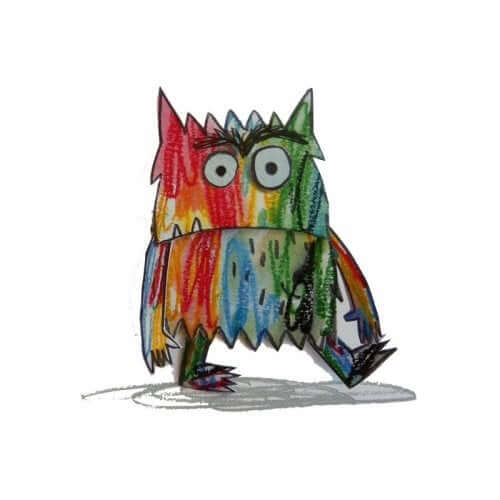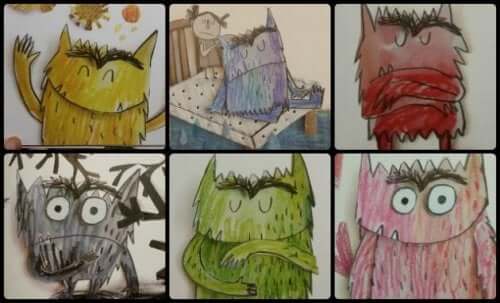"The Color Monster" – 3 Lessons for Kids

The Color Monster is a book written and illustrated by Anna Llenas. The book is perfect for kids, and there are lots of colorful pictures in it. In addition, its plot has a very original twist. In the story, the color monster has a big mess of emotions and has to untangle them.
Children are hooked on this story from the first page because the emotions are so visual. With this book, they’ll learn to identify and manage emotions in a simple and fun way.
The Color Monster and emotions
The main goal of this book is for children to learn to identify emotions. It’s easy for them to see the emotions in pictures. In fact, this is one of the first steps of reading. Therefore, the author uses three different important characteristics:
Facial expressions
The monster shows a different expression for each of the feelings he experiences. For example, when he’s happy, he smiles. However, when he’s angry, he frowns. This part is key because it helps kids learn about how they feel. In addition, they also learn to recognize these expressions in others.
Colors
On the other hand, each color always suggests different feelings. In fact, there are lots of studies on the psychology of color. Usually, we associate bright colors, like yellow, with energy and positivity; we associate dark ones, like black, with negative feelings.
The same thing happens in The Color Monster. Therefore, little kids will associate the positive and negative emotions in the book with the color of the monster.

Other images in The Color Monster
In our minds, there are certain things that we associate with each feeling or color. For example, rain affects our mood and gives us nostalgia or sadness. In turn, we can associate rain with the tears we shed when we’re sad. Finally, we usually associate water with the color blue.
This process of making relationships between everyday elements, feelings and colors occurs on every page of The Color Monster. Therefore, the rain represents the monster’s sadness while the birds show his joy.
Managing emotions
However, The Color Monster goes one step further and delves into emotional intelligence. As we mentioned, the monster is a mess because he feels a lot of emotions at the same time. Children, like adults, can feel this way, and it’s not easy to manage all these emotions.
This story teaches them steps to follow. First, they have to recognize that they feel several emotions at once. Then, they have to identify each one of those emotions. Finally, they should ask why they feel this way. This process of recognition, identification, association and reasoning will help them develop their emotional intelligence.
Importance of The Color Monster
When kids are young, they express their emotions in a simpler way. Therefore, this book helps them establish a direct relationship of cause (feeling) and effect (the reaction). In other words, if I’m sad, I cry; but if I’m happy, I smile.
However, what happens when we grow up? As we get older, we discover new and more complex feelings. If kids have problems managing the most basic emotions, this could become an obstacle in the future.
The Color Monster will help them express their emotions and learn to channel them from a very young age. In addition, encouraging this type of communication will surely help everyone in the family.
How to read the book
Why don’t you read this out loud? You can even do voices for each emotion! Although little kids still don’t know how to read, it’s very easy to follow the story if someone reads out loud to them.
This book is so intuitive that you only need to read it a few times for them to memorize what happens on each page. Afterwards, they’ll be able to share it with others.
In addition, this book has been printed in various formats. For example, there’s a smaller and more manageable version for kids. In fact, there’s also a pop-up version.
All cited sources were thoroughly reviewed by our team to ensure their quality, reliability, currency, and validity. The bibliography of this article was considered reliable and of academic or scientific accuracy.
- La psicología del color en los niños. (n.d.). Retrieved April 5, 2019, from http://www.psicologiadelcolor.es/articulos/psicologia-del-color-en-los-ninos-dibujos/
- Pablo Fernández-Berrocal y Natalio Extremera Pacheco. (1999). Inteligencia Emocional art Universidad de Málaga España. OEI-Revista Iberoamericana de Educación, (LA INTELIGENCIA EMOCIONAL COMO UNA HABILIDAD ESENCIAL EN LA ESCUELA), 1–6. Retrieved from https://www.mendeley.com/viewer/?fileId=6c019e7c-5c97-0857-3efe-25978157b8ea&documentId=e04b34ff-002c-310a-a171-c2cc644d424e
- Llenas Serra, Anna. (2014). El Monstruo de Colores. Editorial Flamboyant, S.L